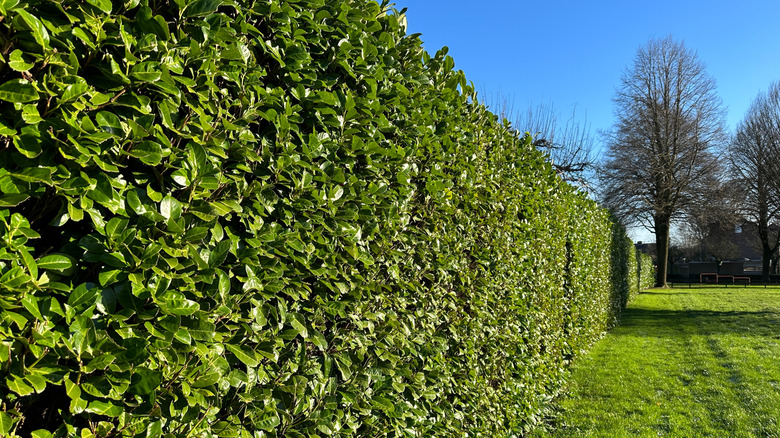The Fast-Growing Small Tree That Doubles As The Perfect Privacy Fence
Looking for an attractive, fast-growing tree that can also function as a screen or privacy fence? Cherry laurel trees (Prunus laurocerasus), sometimes referred to as English laurel, could be the answer to your prayers. Known for its glossy green leaves, fragrant flowers, and namesake berries, this shade-loving perennial shrub grows quickly and super densely, making it one of the best trees to plant for privacy if you have a smaller backyard and want your landscaping to do double duty. It's durable, does well in USDA Hardiness Zones 6 through 9, and can grow up to 20 feet high and 10 feet wide.
Cherry laurel isn't native to the Americas; however, since being introduced stateside via Europe and Asia, it's become naturalized in many parts of the country. Once established, it can last for decades if the conditions are right. There is a catch, though. To keep your cherry laurel tree cute and compact, you'll need to be diligent about pruning it regularly.
Factors to consider before planting a cherry laurel tree
Though it's a gorgeous, functional pick, cherry laurel isn't a universally good option for home landscapers. There are definitely some cons to consider before planting this fast-growing tree on your property. For one thing, all parts of this plant contain cyanogenic compounds and are severely poisonous to humans and animals. Consuming cherry laurel's leaves or berries can lead to weakness, shortness of breath, and respiratory failure. If you have a young child who likes to put things in their mouth or a pet who spends time outside and nibbles on berries or foliage in your yard, then you may want to steer clear of this tree.
And then there's the upkeep. As noted above, cherry laurels grow so rapidly that they require regular pruning to maintain a neat, manicured appearance. They can be aggressive growers and potentially crowd out native flora. In some states, including Oregon and Virginia, they're even considered invasive plants you should never grow. Cherry laurel's berries can get quite messy, too, cluttering the ground and staining walkways. If you're an inexperienced gardener who doesn't know how to prune trees without calling in a pro, or you live in a part of the country where cherry laurels are a no-no, then a different tree might be a better pick for you.
How to plant and care for cherry laurel trees
Ready to plant a cherry laurel tree in your backyard? Aim for early spring or fall. This plant prefers mild temps, so you'll have the best luck in the transitional seasons. Choose a spot that gets partial shade to full sun, and make sure the surrounding soil drains well. If you're planting multiple cherry laurel trees in your yard, space them out decently far apart so each one has room to grow. You'll want to keep the soil consistently moist while your tree is still new; however, once established, cherry laurels don't need much watering outside of dry spells. Pruning aside, these trees are pretty low-maintenance. Just use mulch around their base to help retain moisture. In fact, at that stage, you'll want to watch out for overwatering, which can cause root rot and be detrimental to this plant.
As your cherry laurel tree develops roots and shoots up in size, use garden shears to carefully trim it back to your preferred shape. Remember, this is a hedge you can plant in your yard that will grow fast — don't shy away from frequent pruning! You can (and should) do this regularly throughout its growth season. You can even propagate it, if you feel so inclined. Once its growth stalls in the winter, consider cutting your cherry laurel tree back more severely. That way, new growth in the spring will appear in your desired pattern. As a note, this plant can be afflicted by harsh winters, which burn its leaves out. Look out for dips in temperature and make sure to protect the plant accordingly to keep it looking healthy.


